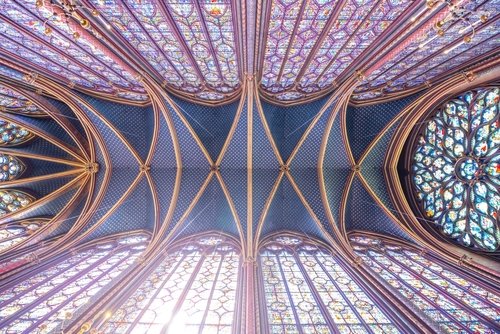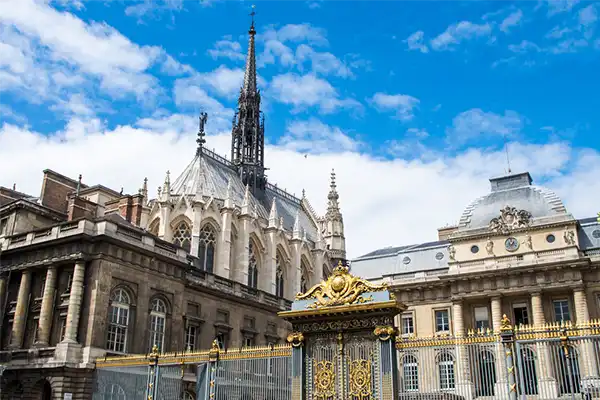History of Sainte-Chapelle
History of Sainte-Chapelle
Step into a realm of unparalleled beauty and historical significance as you explore the Sainte-Chapelle Church in Paris. This masterpiece of Gothic architecture stands as a testament to the artistic and architectural prowess of medieval France, transporting you back to the era of saints and kings.
Delve into the chapel’s rich history, intricately interwoven with the life of King Louis IX, who commissioned its construction to house the sacred relics of Christ’s Passion. Let’s begin with a chronological timeline, followed by an in-depth summary and insights into its remarkable architecture.
History of Sainte-Chapelle: Chronological Timeline
1239
King Louis IX, inspired by a pilgrimage to the Holy Land, commissioned the construction of Sainte-Chapelle on the Île de la Cité in Paris to house the Crown of Thorns, a relic believed to be the crown placed on Jesus Christ’s head during his crucifixion.
1242-48
The construction of Sainte-Chapelle begins under the direction of architect Pierre de Montreuil. The chapel is designed in the Rayonnant Gothic style, characterized by its soaring arches, intricate ornamentation, and abundant stained-glass windows.
1248
Sainte-Chapelle is consecrated, marking its completion. The chapel is dedicated to the Holy Trinity and serves as a royal chapel for the French monarchy.
1379
Charles V of France presents the Sainte-Chapelle Gospels to the chapel, commissioned from leading Parisian illuminators in the late 13th century. The Gospels feature elaborately decorated initials, delicate figures, and biblical scenes.
15th Century
The relics housed in Sainte-Chapelle, including the Crown of Thorns, are moved to Notre Dame Cathedral. The chapel’s role as a royal chapel diminishes, and it is used for various purposes, including a music school and a prison.
16th Century
The stained-glass windows of Sainte-Chapelle are partially destroyed during the Protestant Reformation, which led to iconoclasm and the destruction of religious images.
17th Century
The upper chapel of Sainte-Chapelle is transformed into an exhibition space for the royal collection of ancient statues and artifacts.
French Revolution (1789-1799)
Sainte-Chapelle suffers significant damage during the French Revolution, as revolutionaries dismantle its religious iconography and use the chapel as a prison and a stable. The stained-glass windows are further damaged or destroyed.
19th Century
Restoration efforts begin in the early 19th century, led by architects Eugène Viollet-le-Duc and Jean-Baptiste Lassus. The chapel’s stained-glass windows are carefully repaired, and the interior is restored to its former splendor.
1979
Sainte-Chapelle is designated a UNESCO World Heritage Site for its exceptional artistic and architectural significance.
20th and 21st centuries
Sainte-Chapelle remains a popular tourist destination and a revered landmark of Parisian history. The chapel hosts concerts, exhibitions, and other cultural events, and its stained-glass windows continue to captivate visitors with their beauty and artistry.
History of Sainte-Chapelle: In-depth Summary
Delve into the rich history of Sainte-Chapelle with our intricately crafted overview. Immerse yourself in each meticulously presented segment, traversing through time to unveil the origins, transformations, and profound cultural significance of this iconic architectural gem.




Architecture of Sainte-Chapelle
Sainte-Chapelle, a masterpiece of French Gothic architecture, stands as a testament to the artistic and architectural prowess of the 13th century. Commissioned by King Louis IX to house the Crown of Thorns, the chapel was designed by architect Pierre de Montreuil and completed in 1248.
The chapel’s design exemplifies the Rayonnant Gothic style, characterized by its soaring arches, intricate ornamentation, and abundant stained-glass windows. The lower chapel, dedicated to the Virgin Mary, is austere in its design, while the upper chapel, dedicated to the Holy Trinity, is a spectacle of light and color, with over 6,500 square feet of stained-glass windows depicting scenes from the Old and New Testaments.
The chapel’s artistic elements further enhance its visual appeal. The Royal Gallery, a narrow corridor above the upper chapel, offers a unique perspective of the stained-glass windows, while the Sainte-Chapelle Gospels, a beautifully illuminated manuscript, adds to the chapel’s rich artistic heritage.




Sainte-Chapelle Tickets & Tours
Immerse yourself in the world of Sainte-Chapelle with our carefully curated collection of tickets and guided tours.
















